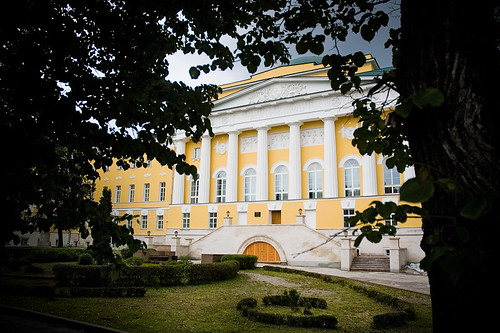Yesterday I mentioned Dostoevsky. And today while reading a book on architecture I found an interesting quote by him. It seems to be a very short introduction to Russian architecture of the XIX century.
I wasn't going to start my blog only with Dostoevsky. But what can I do? He follows me.
Then meet an architectural guide to Moscow by Fyodr Mikhailovitch.
"In these buildings you can read as in a book all the currents of all the great and trivial ideas that, appropriately or accidentally, have landed here from Europe and that gradually overcame and captured us.
Here we see the pallid architecture of churches of the last century;
here is a pitiful imitation in Roman style from the beginning of our century;
here we see a building that seems to have come from the Renaissance era; and there is an example of the ancient Byzantine style, supposedly discovered by the arcitect Ton during the reign of Nicholas I.
And then we see some more buildings— hospitals, institutes, and even palaces from the first decades of our century;
these are in the style of Napoleon I— immense, pseudomajestic and unbelievably boring;
there is something labored and contrived in the style which, like the bees on Napoleon's mantle, is supposed to express the majesty of the new epoch that had then just begun and the unprecedented dynasty with its pretentions to existence in perpetuity.
And then we see some houses, or palaces almost, belonging to certain of our noble families but products of a much later period. These are built in the manner of some Italian palazzi or in the not entirely pure French style of the prerevolutionary era.
And now, and now . . . you really don't know how to define our current architecture. It's a sort of disorderly mess, entirely, by the way, appropriate to the disorder of the present moment. It's a multitude of extremely tall (the main thing is tall) apartment houses, extremely thin walled and cheaply built (they say), with amazing architecture on the facades: here we have Rastrelli, there the late baroque, over here the balconies and windows of some doge, always oeil de boeuf [windows], and always five stories, and all this in the same facade."
F. Dostoevsky, Little pictures from A Writer's Diary
I wasn't going to start my blog only with Dostoevsky. But what can I do? He follows me.
Then meet an architectural guide to Moscow by Fyodr Mikhailovitch.
"In these buildings you can read as in a book all the currents of all the great and trivial ideas that, appropriately or accidentally, have landed here from Europe and that gradually overcame and captured us.
Here we see the pallid architecture of churches of the last century;
here is a pitiful imitation in Roman style from the beginning of our century;
here we see a building that seems to have come from the Renaissance era; and there is an example of the ancient Byzantine style, supposedly discovered by the arcitect Ton during the reign of Nicholas I.
And then we see some more buildings— hospitals, institutes, and even palaces from the first decades of our century;
these are in the style of Napoleon I— immense, pseudomajestic and unbelievably boring;
there is something labored and contrived in the style which, like the bees on Napoleon's mantle, is supposed to express the majesty of the new epoch that had then just begun and the unprecedented dynasty with its pretentions to existence in perpetuity.
And then we see some houses, or palaces almost, belonging to certain of our noble families but products of a much later period. These are built in the manner of some Italian palazzi or in the not entirely pure French style of the prerevolutionary era.
And now, and now . . . you really don't know how to define our current architecture. It's a sort of disorderly mess, entirely, by the way, appropriate to the disorder of the present moment. It's a multitude of extremely tall (the main thing is tall) apartment houses, extremely thin walled and cheaply built (they say), with amazing architecture on the facades: here we have Rastrelli, there the late baroque, over here the balconies and windows of some doge, always oeil de boeuf [windows], and always five stories, and all this in the same facade."







Комментариев нет:
Отправить комментарий